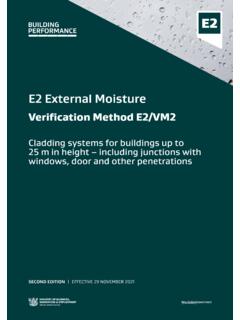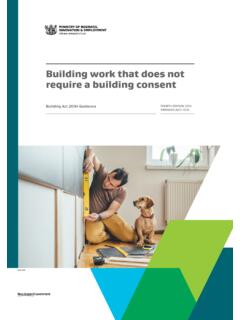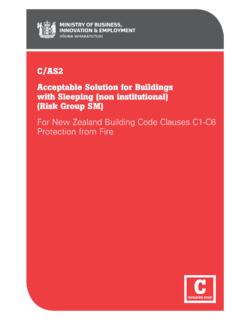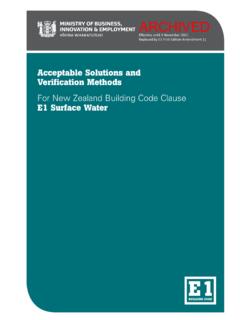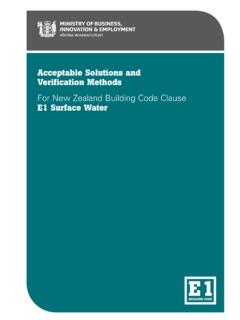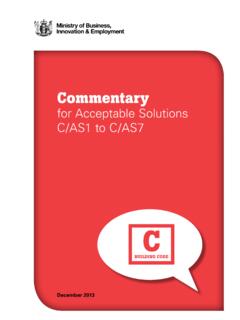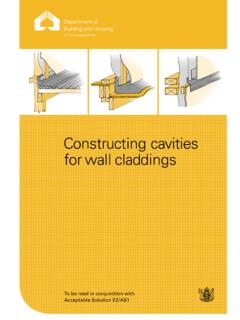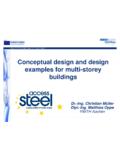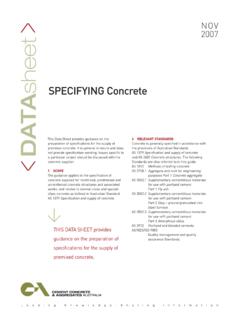Transcription of Module 4: Earthquake resistant foundation design
1 Earthquake geotechnical engineering practiceMODULE 4: Earthquake resistant foundation designDATE: NOVEMBER 2016 REVISION: 0 Module 4: Earthquake resistant foundation DESIGNPAGE B4 AcknowledgementsNZGS/MBIE Editorial Panel Dr Kevin McManus McManus Geotech Ltd (author) Prof Misko Cubrinovski University of Canterbury Charlie Price MWH Global, (NZGS Chair) John Scott Ministry of Business, Innovation & Employment Dr Gilles Seve Ministry of Business, Innovation & Employment Mike Stannard Ministry of Business, Innovation & Employment Nick Traylen Geotech Consulting Ltd, MBIE s Engineering Advisory Group Rick Wentz Wentz Pacific LtdOverview Prof Jonathan Bray University of California Berkeley Gavin Alexander BECA LtdFunding Organisations MBIE EQC NZGSR eviewers Prof Mike Pender University of Auckland Ian McCahon Geotech Consulting Ltd John Hare Holmes Group Ltd Stuart Palmer Tonkin & Taylor Prof Alain Pecker Ecole Nationale des Ponts et Chauss es Paris Nick Harwood Eliot Sinclair & Partners Kevin Anderson NZGS AECOM LtdDocument statusISBN: 978-0-947524-47-0 (print) ISBN.
2 978-0-947524-48-7 (online)New Zealand Geotechnical Society (NZGS) and Ministry of Business Innovation & Employment (MBIE) Earthquake Geotechnical Engineering Practice in New ZealandRev 0 Issue Date: November 2016 New Zealand Geotechnical Society (NZGS) c/ Institution of Professional Engineers New Zealand PO Box 12 241 Wellington 6013 Ministry of Business Innovation & Employment (MBIE) Building System Performance Branch PO Box 1473 Wellington 6140 This document is published by the Chief Executive of MBIE as guidance under section 175 of the Building Act 2004 to assist parties to comply with their obligations under the Building Act 2004. It is not mandatory to follow the guidance, but if followed: it does not relieve any person of the obligation to consider any matter to which that information relates according to the circumstances of the particular case; users should consider taking appropriate professional advice prior to entering into a construction contract which incorporates all or parts of this document.
3 While the Ministry of Business, Innovation & Employment, and the New Zealand Geotechnical Society have taken care in preparing this document, it is only a guide and, if used, does not relieve any person of the obligation to consider any matter to which that information relates, according to the circumstances of the case. All users should satisfy themselves as to the applicability of the content and should not act on the basis of any matter contained in this document without considering, and if necessary, taking appropriate professional advice. The document may be updated from time to time and the latest version is available from the Ministry s website at or the New Zealand Geotechnical Society s website at noticeThis document is preliminary and the contents should be treated as draft guidelines.
4 Submissions by the geotechnical community to the Society (email: are encouraged, after which a further review will be undertaken. The contents may be subject to further changes, additions, and deletions. Copyright The copyright owner authorises reproduction of this work, in whole or in part, so long as no charge is made for the supply of copies, and the integrity and attribution of the contributors and publishers of the document is not interfered with in any : NOVEMBER 2016 REVISION: 0 Module 4: Earthquake resistant foundation DESIGNPAGE 14contentsCONTENTSPREFACE 31 INTRODUCTION Objectives Scope Intended audience Professional collaboration Organisation of this Module 72 SITE GEOTECHNICAL MODEL Selection of representative design parameters 93 foundation PERFORMANCE OBJECTIVES FOR Earthquake LOADING Introduction Regulatory environment Serviceability limit state (SLS) Ultimate limit state (ULS))
5 Intermediate limit states LRFD design procedure LRFD design with Earthquake loading Soil structure interaction Performance based design 214 SITE ASSESSMENT AND foundation SELECTION Introduction Soil liquefaction Lateral spreading Other site stability issues Natural raft ground improvement Sand-like soils with FL > 1 Clay-like soils 31 DATE: NOVEMBER 2016 REVISION: 0 Module 4: Earthquake resistant foundation DESIGNPAGE Settlement Free field settlement Building induced settlements Other settlement sources Shallow foundation requirements Deep foundation requirements 345 SHALLOW foundation design Introduction Types of shallow foundations Pad footings and strip footings Gravity design procedure Seismic design procedure foundation beams design of mats and rafts Gravity design procedures Seismic design procedure 436 DEEP foundation design Types of deep foundations Driven piles Bored piles Belled piles CFA piles Screw piles Gravity design procedures Seismic design procedures Axial load capacity and settlement Lateral load resistance and kinematic effects 547 REFERENCES
6 57 DATE: NOVEMBER 2016 REVISION: 0 Module 4: Earthquake resistant foundation DESIGNPAGE 34prefacePREFACEThis document is part of a series of guidance modules developed jointly by the Ministry of Business, Innovation & Employment (MBIE) and the New Zealand Geotechnical Society (NZGS). The guidance series along with an education programme aims to lift the level and improve consistency of Earthquake geotechnical engineering practice in New Zealand, to address lessons from the Canterbury Earthquake sequence and Canterbury Earthquakes Royal Commission recommendations. It is aimed at experienced geotechnical professionals, bringing up to date international research and practice. This document should be read in conjunction with the other modules published to date in the series: Module 1: Overview of the Guidelines Module 2: Geotechnical investigations for Earthquake engineering Module 3: Identification, assessment and mitigation of liquefaction hazards Module 5A: Specification of ground improvement for residential properties in the Canterbury regionOn-line training material in support of the series is available on the MBIE and NZGS websites, and Further documents are under development and will be published progressively during 2017.
7 Undertaking adequate geotechnical investigations to understand likely ground performance in earthquakes is an essential aspect of good and economic building design . We would encourage you to make yourselves familiar with the guidance and apply it appropriately in Price Mike Stannard Chair Chief Engineer New Zealand Ministry of Business Geotechnical Society Innovation & EmploymentDATE: NOVEMBER 2016 REVISION: 0 Module 4: Earthquake resistant foundation DESIGNPAGE 44introduction1 INTRODUCTIONNew Zealand is a high Earthquake hazard region and Earthquake considerations are integral to the design of the built environment in New Zealand. The effects of Earthquake shaking need to always be considered in geotechnical engineering practice and frequently are found to govern high seismic hazard in New Zealand and profound relevance of geotechnical Earthquake engineering were demonstrated by the Canterbury Earthquake Sequence.
8 Christchurch and Canterbury were hit hard by a series of strong earthquakes generated by previously unmapped faults located in the vicinity or within the city boundaries. Many buildings in the Christchurch CBD were on shallow foundations and some of these were badly affected by liquefaction including excessive settlements and tilting. Shallow foundations bearing onto the shallow, dense gravels present in some parts of the city showed mixed performance because of the high variability of these deposits and high seismic loads. Stiff raft foundations bearing onto these shallow gravels appear to have performed relatively foundations on the few sites where ground improvement was carried out prior to construction showed mixed performance. While bearing failures were prevented by the ground improvement, in accordance with the design philosophy, there were excessive differential settlements and tilting in some : NOVEMBER 2016 REVISION: 0 Module 4: Earthquake resistant foundation DESIGNPAGE 54 Buildings on deep pile foundations generally fared better where the piles penetrated to competent soils at depth of adequate thickness and not underlain by liquefied soil.
9 However, a significant number of piled buildings suffered differential settlement where the bearing layer has been too thin or underlain with liquefiable layers or where there has been a loss of side resistance with liquefaction and consequent load transfer to an end bearing foundations, where part of the building was supported on deep piles and part on shallow foundations, performed poorly because of complex dynamic interactions resulting in differential movements between the two significant foundation damage included the failure of ground floor and basement slabs in uplift under the very high pore-water pressures associated with soil liquefaction and ground it is acknowledged that the level of shaking far exceeded even the ultimate limit state (ULS) design level of shaking, a better understanding of site geotechnical performance during earthquakes is desirable in future in urban centres in New Zealand.
10 This should lead to better foundation performance in order to achieve greater resilience and reparability for the building ObjectivesThis document is intended to provide guidance for Earthquake resistant design of foundations for buildings in New Zealand. It is not intended to provide a fully comprehensive treatment of all aspects of foundation design and construction in all situations and ground conditions for which well-known published handbooks should be consulted, for example: Salgado (2007) Tomlinson and Boorman (2001) Bowles (1997) FHWA (Bored Piles, Brown et. al. 2010) FHWA (Driven Piles, Hannigan 2006)Instead, the intention is to provide supplementary guidance on Earthquake design aspects for foundations that are not well covered in these handbooks or elsewhere.


